Submarine Groundwater Discharge in the Nice Airport Landslide Area
Simple Summary
Abstract
1. Introduction
1.1. Geological Background
1.2. The 1979 Landslide
2. Materials and Methods
2.1. Offshore Data
2.1.1. KATERINA and CTD
2.1.2. Spectra Analysis and FFT
2.1.3. Piezometer
2.1.4. Bathymetry
2.2. Onshore Data
2.2.1. Groundwater Piezometer
2.2.2. Var River Discharge
3. Results
3.1. Test Run and Placement Search 2018
3.2. Smoothing of Long-Term Data 2019
3.3. Piezometer Data
4. Discussion
4.1. Rain Events 2019
4.2. Using FFT to Identify Submarine Groundwater Discharge
4.3. Long- and Short-Term Pore Pressure Changes
4.4. Quantifying SGD
5. Conclusions
Author Contributions
Funding
Data Availability Statement
Acknowledgments
Conflicts of Interest
References
- Maslin, M.; Owen, M.; Day, S.; Long, D. Linking continental-slope failures and climate change: Testing the clathrate gun hypothesis. Geology 2004, 32, 53–56. [Google Scholar] [CrossRef]
- Burnett, W.C.; Aggarwal, P.K.; Aureli, A.; Bokuniewicz, H.; Cable, J.E.; Charette, M.A.; Kontar, E.; Krupa, S.; Kulkarni, K.M.; Loveless, A.; et al. Quantifying submarine groundwater discharge in the coastal zone via multiple methods. Sci. Total Environ. 2006, 367, 498–543. [Google Scholar] [CrossRef] [PubMed]
- Kim, G.; Hwang, D.-W. Tidal pumping of groundwater into the coastal ocean revealed from submarine 222Rn and CH4 monitoring. Geophys. Res. Lett. 2002, 29, 23-1–23-4. [Google Scholar] [CrossRef]
- Tsabaris, C.; Scholten, J.; Karageorgis, A.P.; Comanducci, J.F.; Georgopoulos, D.; Wee Kwong, L.L.; Patiris, D.L.; Papathanassiou, E. Underwater in situ measurements of radionuclides in selected submarine groundwater springs, Mediterranean Sea. Radiat. Prot. Dosim. 2010, 142, 273–281. [Google Scholar] [CrossRef]
- Anthony, E.J.; Julian, M. The 1979 Var Delta Landslide on the French Riviera: A Retrospective Analysis. J. Coast. Res. 1997, 13, 27–35. [Google Scholar]
- Kopf, A.J.; Kasten, S.; Blees, J. Geochemical Evidence for Groundwater-Charging of Slope Sediments: The Nice Airport 1979 Landslide and Tsunami Revisited. In Submarine Mass Movements and Their Consequences; Mosher, D.C., Shipp, R.C., Moscardelli, L., Chaytor, J.D., Baxter, C.D.P., Lee, H.J., Urgeles, R., Eds.; Springer: Dordrecht, The Netherlands, 2010; pp. 203–214. [Google Scholar] [CrossRef]
- Stegmann, S.; Sultan, N.; Kopf, A.; Apprioual, R.; Pelleau, P. Hydrogeology and its effect on slope stability along the coastal aquifer of Nice, France. Mar. Geol. 2011, 280, 168–181. [Google Scholar] [CrossRef]
- Oehler, T.; Mogollón, J.M.; Moosdorf, N.; Winkler, A.; Kopf, A.; Pichler, T. Submarine groundwater discharge within a landslide scar at the French Mediterranean coast. Estuar. Coast. Shelf Sci. 2017, 198, 128–137. [Google Scholar] [CrossRef]
- Sultan, N.; Garziglia, S.; Bompais, X.; Woerther, P.; Witt, C.; Kopf, A.; Migeon, S. Transient Groundwater Flow Through a Coastal Confined Aquifer and Its Impact on Nearshore Submarine Slope Instability. J. Geophys. Res. Earth Surf. 2020, 125, e2020JF005654. [Google Scholar] [CrossRef]
- Guglielmi, Y.; Prieur, L. Locating and estimating submarine freshwater discharge from an interstitial confined coastal aquifer by measurements at sea: Example from the lower Var valley, France. J. Hydrol. 1997, 190, 111–122. [Google Scholar] [CrossRef]
- Tsabaris, C.; Bagatelas, C.; Dakladas, T.; Papadopoulos, C.T.; Vlastou, R.; Chronis, G.T. An autonomous in situ detection system for radioactivity measurements in the marine environment. Appl. Radiat. Isot. 2008, 66, 1419–1426. [Google Scholar] [CrossRef]
- Burnett, W.C.; Dulaiova, H. Estimating the dynamics of groundwater input into the coastal zone via continuous radon-222 measurements. J. Environ. Radioact. 2003, 69, 21–35. [Google Scholar] [CrossRef] [PubMed]
- Jones, D.G. Development and application of marine gamma-ray measurements: A review. J. Environ. Radioact. 2001, 53, 313–333. [Google Scholar] [CrossRef] [PubMed]
- Santos, I.R.; Dimova, N.; Peterson, R.N.; Mwashote, B.; Chanton, J.; Burnett, W.C. Extended time series measurements of submarine groundwater discharge tracers (222Rn and CH4) at a coastal site in Florida. Mar. Chem. 2009, 113, 137–147. [Google Scholar] [CrossRef]
- Charette, M.A.; Moore, W.S.; Burnett, W.C. Chapter 5 Uranium- and Thorium-Series Nuclides as Tracers of Submarine Groundwater Discharge. In Radioactivity in the Environment; Krishnaswami, S., Cochran, J.K., Eds.; Elsevier: Amsterdam, The Netherlands, 2008; Volume 13, pp. 155–191. [Google Scholar] [CrossRef]
- Savoye, B.; Piper, D.J.W.; Droz, L. Plio-Pleistocene evolution of the Var deep-sea fan off the French Riviera. Mar. Pet. Geol. 1993, 10, 550–571. [Google Scholar] [CrossRef]
- Lofi, J.; Pezard, P.; Bouchette, F.; Raynal, O.; Sabatier, P.; Denchik, N.; Levannier, A.; Dezileau, L.; Certain, R. Integrated Onshore-Offshore Investigation of a Mediterranean Layered Coastal Aquifer. Ground Water 2012, 51, 550–561. [Google Scholar] [CrossRef]
- Lofi, J.; Rabineau, M.; Gorini, C.; Berne, S.; Clauzon, G. Plio–Quaternary prograding clinoform wedges of the western Gulf of Lion continental margin (NW Mediterranean) after the Messinian Salinity Crisis. Mar. Geol. 2003, 198, 289–317. [Google Scholar] [CrossRef]
- Kopf, A.J.; Stegmann, S.; Garziglia, S.; Henry, P.; Dennielou, B.; Haas, S.; Weber, K.-C. Soft sediment deformation in the shallow submarine slope off Nice (France) as a result of a variably charged Pliocene aquifer and mass wasting processes. Sediment. Geol. 2016, 344, 290–309. [Google Scholar] [CrossRef]
- Migeon, S.; Cattaneo, A.; Hassoun, V.; Dano, A.; Casedevant, A.; Ruellan, E. Failure Processes and Gravity-Flow Transformation Revealed by High-Resolution AUV Swath Bathymetry on the Nice Continental Slope (Ligurian Sea). In Submarine Mass Movements and Their Consequences; Springer: Dordrecht, The Netherlands, 2012; pp. 451–461. [Google Scholar] [CrossRef]
- Klaucke, I.; Savoye, B.; Cochonat, P. Patterns and processes of sediment dispersal on the continental slope off Nice, SE France. Mar. Geol. 2000, 162, 405–422. [Google Scholar] [CrossRef]
- Sultan, N.; Cochonat, P.; Canals, M.; Cattaneo, A.; Dennielou, B.; Haflidason, H.; Laberg, J.S.; Long, D.; Mienert, J.; Trincardi, F.; et al. Triggering mechanisms of slope instability processes and sediment failures on continental margins: A geotechnical approach. Mar. Geol. 2004, 213, 291–321. [Google Scholar] [CrossRef]
- Guglielmi, Y. Hydrogéologie Des Aquifères Plio-Quaternaires de la Basse Vallée du Var (Alpes-Maritimes, France): Contrôle Néotectonique Des Écoulements Souterrains: L’outil, Chimique et Isotopique, Pour L’étude du Fonctionnement et de la Vulnérabilité Des Aquifères. Ph.D. Thesis, Université d’Avignon et des pays de Vaucluse, Avignon, France, 1993. [Google Scholar]
- Guglielmi, Y.; Mudry, J. Estimation of Spatial and Temporal Variability of Recharge Fluxes to an Alluvial Aquifer in a Fore Land Area by Water Chemistry and Isotopes. Ground Water 1996, 34, 1017–1023. [Google Scholar] [CrossRef]
- Potot, C.; Féraud, G.; Schärer, U.; Barats, A.; Durrieu, G.; Le Poupon, C.; Travi, Y.; Simler, R. Groundwater and river baseline quality using major, trace elements, organic carbon and Sr–Pb–O isotopes in a Mediterranean catchment: The case of the Lower Var Valley (south-eastern France). J. Hydrol. 2012, 472–473, 126–147. [Google Scholar] [CrossRef]
- Emily, A.; Tennevin, G.; Mangan, C. Etude Hydrogéologique des Nappes Profondes de la Basse Vallée du Var (Alpes-Maritimes); Conseil Général Alpes Maritimes: Nice, France, 2010; 53p. [Google Scholar]
- SolsEssais. Sols Essais Internal Report; SolsEssais: Aix-en-Provence, France, 1994. [Google Scholar]
- Leynaud, D.; Sultan, N. 3-D slope stability analysis: A probability approach applied to the nice slope (SE France). Mar. Geol. 2010, 269, 89–106. [Google Scholar] [CrossRef]
- Dan, G.; Sultan, N.; Savoye, B. The 1979 Nice harbour catastrophe revisited: Trigger mechanism inferred from geotechnical measurements and numerical modelling. Mar. Geol. 2007, 245, 40–64. [Google Scholar] [CrossRef]
- Mulder, T.; Savoye, B.; Syvitski, J.P.M. Numerical modelling of a mid-sized gravity flow: The 1979 Nice turbidity current (dynamics, processes, sediment budget and seafloor impact). Sedimentology 1997, 44, 305–326. [Google Scholar] [CrossRef]
- Ioualalen, M.; Migeon, S.; Sardoux, O. Landslide tsunami vulnerability in the Ligurian Sea: Case study of the 1979 October 16 Nice international airport submarine landslide and of identified geological mass failures. Geophys. J. Int. 2010, 181, 724–740. [Google Scholar] [CrossRef]
- Dugan, B.; Flemings, P. Fluid flow and stability of the US continental slope offshore New Jersey from the Pleistocene to the present. Geofluids 2002, 2, 137–146. [Google Scholar] [CrossRef]
- Bompais, X.; Garziglia, S.; Blandin, J.; Hello, Y. EMSO-Ligure Nice, a Coastal Cabled 540 Observatory Dedicated to the Study of Slope Stability. In Proceedings of the OCEANS 2019—Marseille, Marseille, France, 17–20 June 2019. [Google Scholar]
- Garziglia, S.; Sultan, N.; Thomas, Y.; Ker, S.; Marsset, B.; Bompais, X.; Woerther, P.; Witt, C.; Kopf, A.; Apprioual, R. Assessing Spatio-Temporal Variability of Free Gas in Surficial Cohesive Sediments Using Tidal Pressure Fluctuations. J. Geophys. Res. Earth Surf. 2021, 126, e2021JF006131. [Google Scholar] [CrossRef]
- Tsabaris, C.; Patiris, D.L.; Karageorgis, A.P.; Eleftheriou, G.; Papadopoulos, V.P.; Georgopoulos, D.; Papathanassiou, E.; Povinec, P.P. In-situ radionuclide characterization of a submarine groundwater discharge site at Kalogria Bay, Stoupa, Greece. J. Environ. Radioact. 2012, 108, 50–59. [Google Scholar] [CrossRef]
- Du, M. Modélisation Intégrée Des Ecoulements Souterrains et Des Echanges Nappe-Rivière Dans la Basse Vallée du Var (Integrated Hydraulic Modeling of Groundwater Flow and River-Aquifer Exchanges in the Lower Valley of Var River). Ph.D. Thesis, Université Nice-Sophia Antipolis, Nice, France, 2016. [Google Scholar]
- Roesner, A.; Wiemer Gv Kreiter, S.; Wenau, S.; Wu, T.-W.; Courboulex, F.; Spiess, V.; Kopf, A. Impact of seismicity on Nice slope stability—Ligurian Basin, SE France: A geotechnical revisit. Landslides 2019, 16, 23–35. [Google Scholar] [CrossRef]
- Tsabaris, C.; Ballas, D. On line gamma-ray spectrometry at open sea. Appl. Radiat. Isot. 2005, 62, 83–89. [Google Scholar] [CrossRef]
- Kopf, A.; Alexandrakis, E.C.C.; Blees, J.; Bogus, K.; Dennielou, B.; Förster, A.; Girault, F.E.; Haarmann, T.; Hanff, H.; Hentscher, M.; et al. Report and preliminary results of meteor cruise M73/1: LIMA-LAMO. In Berichte aus dem Fachbereich Geowissenschaften der Universität Bremen, Bremen (Germany), No. 264; Bremen University: Bremen, Germany, 2008; 169p, Available online: https://www.google.com/url?sa=t&rct=j&q=&esrc=s&source=web&cd=&ved=2ahUKEwjR5I30sP-MAxV6SvEDHYFwNskQFnoECBkQAQ&url=https%3A%2F%2Fmedia.suub.uni-bremen.de%2Fbitstream%2Felib%2F3884%2F1%2F00010386.pdf&usg=AOvVaw1chPSfllumETTQqQBfxR9q&opi=89978449 (accessed on 27 April 2025).
- Kopf, A.; Apprioual, R.; Blandin, J.; Brulport, J.-P.; Crassous, P.; Fleischmann, T.; Förster, A.; Guyader, G.; Hammerschmidt, S.; Henry, P.; et al. Report and preliminary results of poseidon cruise P386: Nail (Nice Airport Landslide). In Berichte aus dem Fachbereich Geowissenschaften der Universität Bremen, Bremen (Germany), No. 271; Bremen University: Bremen, Germany, 2009; 161p, Available online: https://www.google.com/url?sa=t&rct=j&q=&esrc=s&source=web&cd=&ved=2ahUKEwisorWhzP-MAxUvBNsEHS8oJDAQFnoECA4QAQ&url=https%3A%2F%2Foceanrep.geomar.de%2Fid%2Feprint%2F25647%2F1%2FPOS_386.pdf&usg=AOvVaw0WdknSIlG2YeikQERxJ76X&opi=89978449 (accessed on 27 April 2025).
- Kopf, A.; Belke-Brea, M.; Ferentinos, G.; Fleischmann, T.; Geraga, M.; Kufner, S.; Schlenzek, S.; Steiner, A.; Tryon, M.; Wiemer, G. Report and preliminary results of rv poseidon cruise P429: Medfluids: Slope Stability, Mud volcanism, Faulting and Fluid Flow in the Eastern Mediterranean Sea (Cretan Sea, Mediterranean Ridge) and Ligurian Margin (Nice slope). In Berichte aus dem Fachbereich Geowissenschaften der Universität Bremen, Bremen (Germany), No. 286; Bremen University: Bremen, Germany, 2012; 80p, Available online: https://www.google.com/url?sa=t&rct=j&q=&esrc=s&source=web&cd=&ved=2ahUKEwja46O7zP-MAxW8SfEDHfedNwIQFnoECBwQAQ&url=https%3A%2F%2Fmedia.suub.uni-bremen.de%2Fbitstream%2Felib%2F3044%2F1%2F00103965-1.pdf&usg=AOvVaw0ixuQdMkntJZaz2ZqrMHVy&opi=89978449 (accessed on 27 April 2025).
- Kelner, M.; Migeon, S.; Tric, E.; Couboulex, F.; Dano, A.; Lebourg, T.; Taboada, A. Frequency and triggering of small-scale submarine landslides on decadal timescales: Analysis of 4D bathymetric data from the continental slope offshore Nice (France). Mar. Geol. 2016, 379, 281–297. [Google Scholar] [CrossRef]
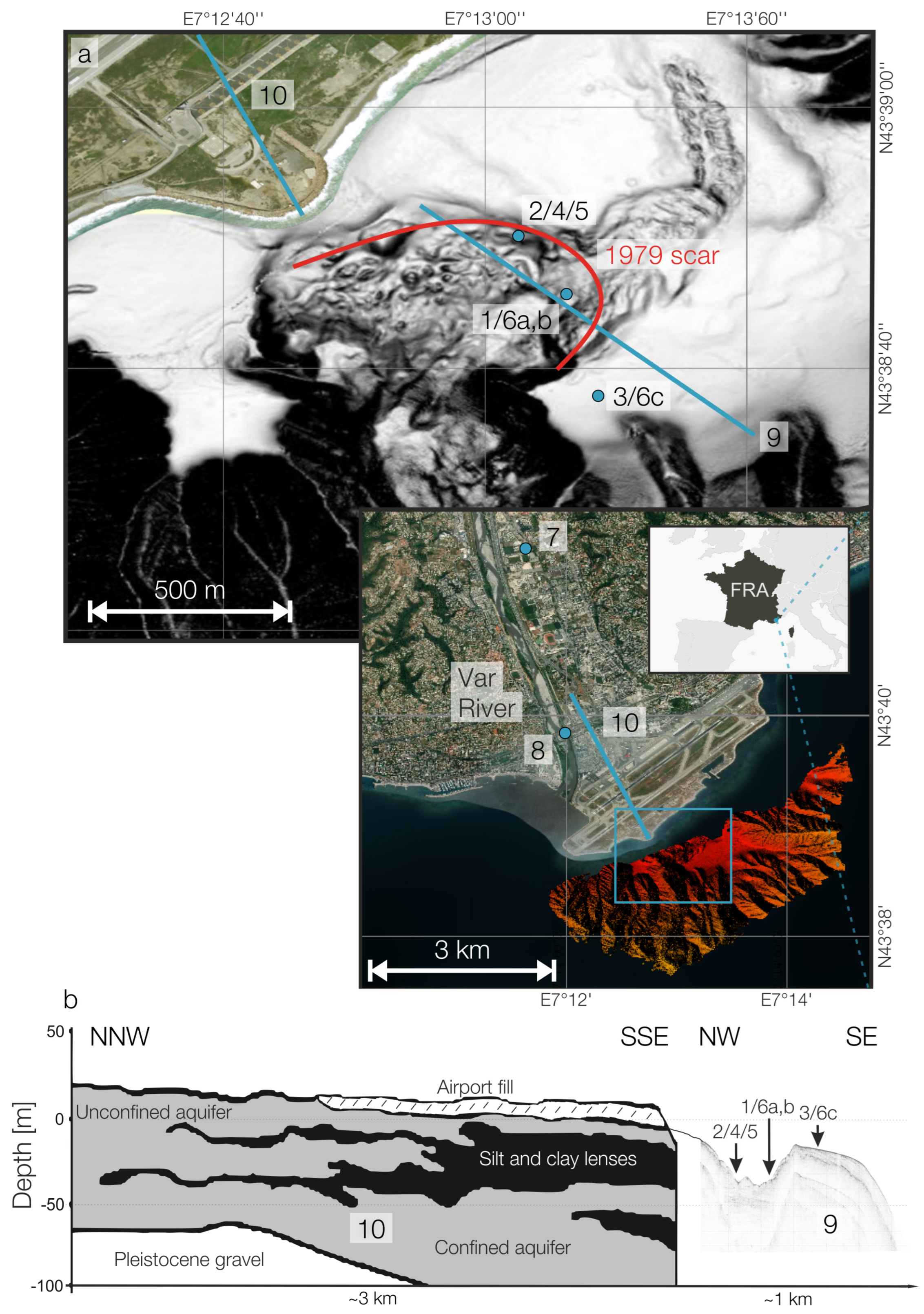
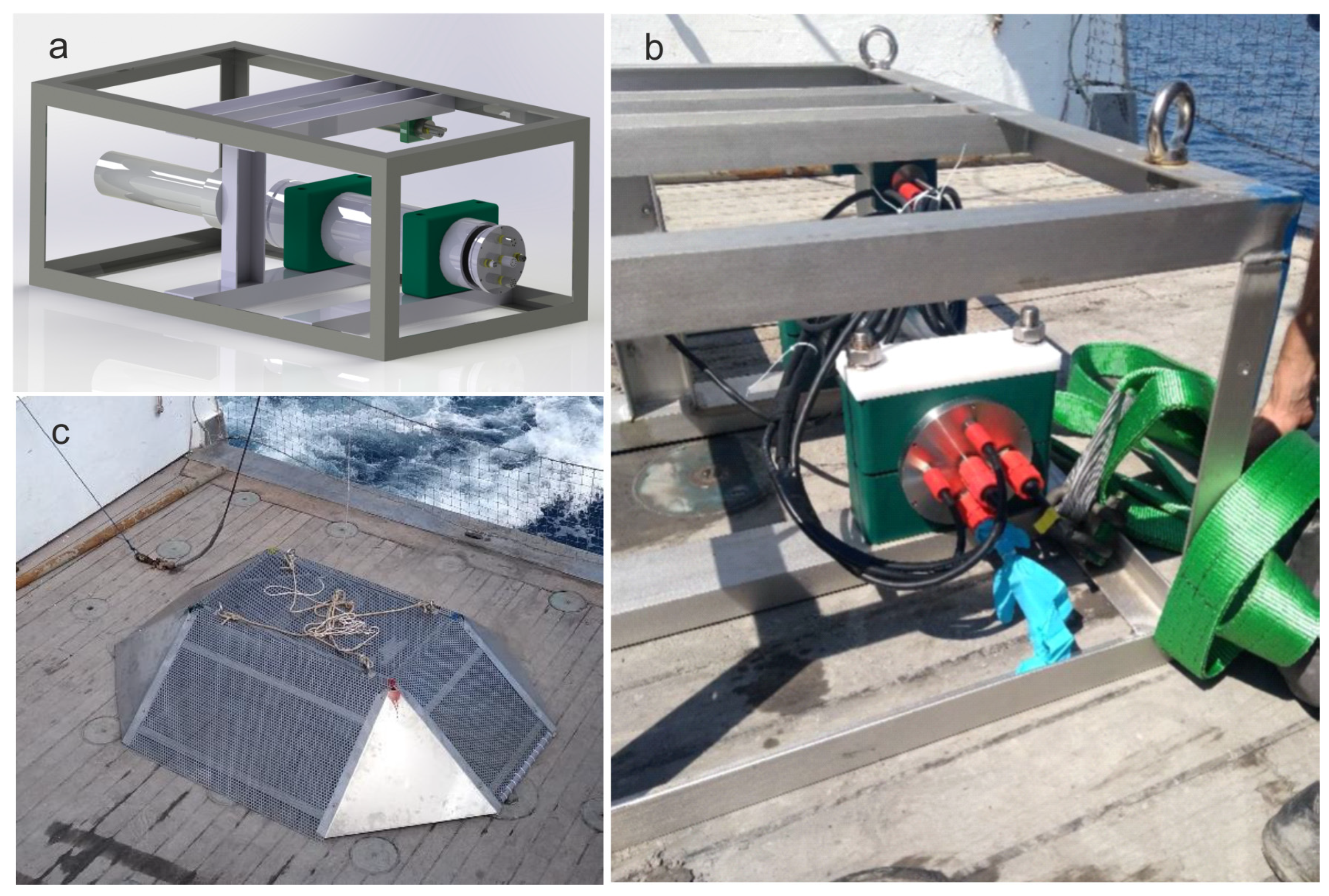
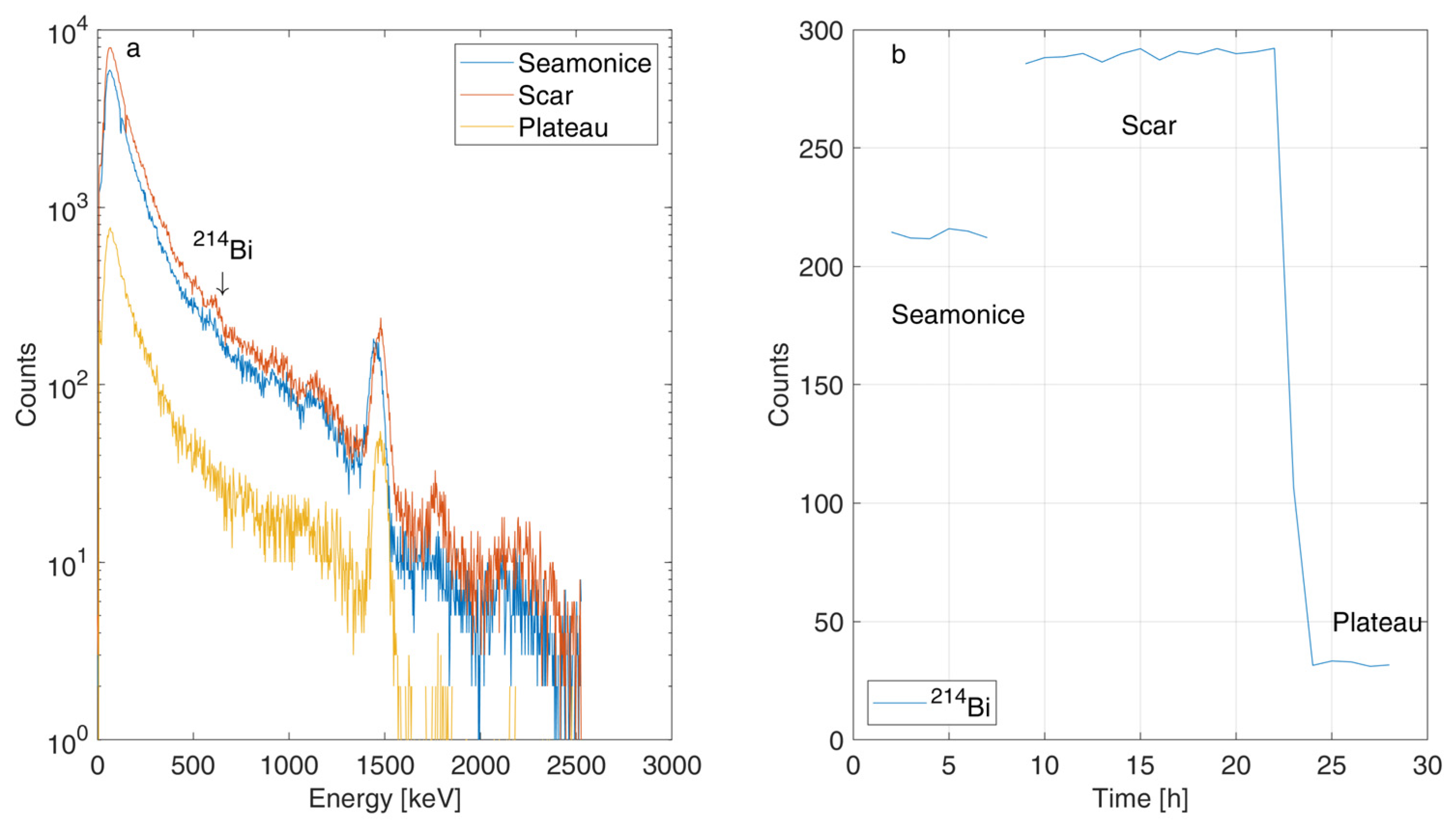

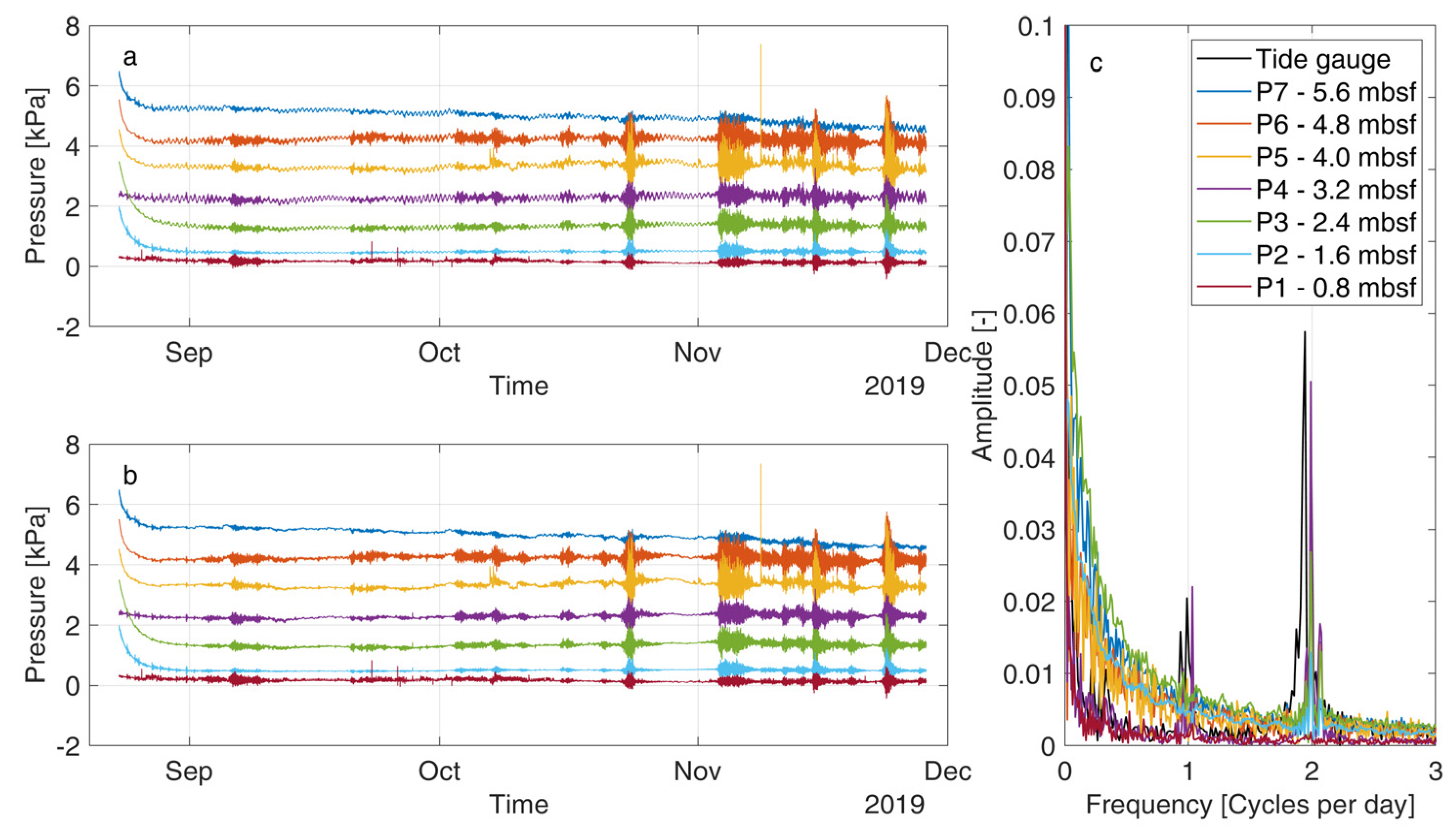
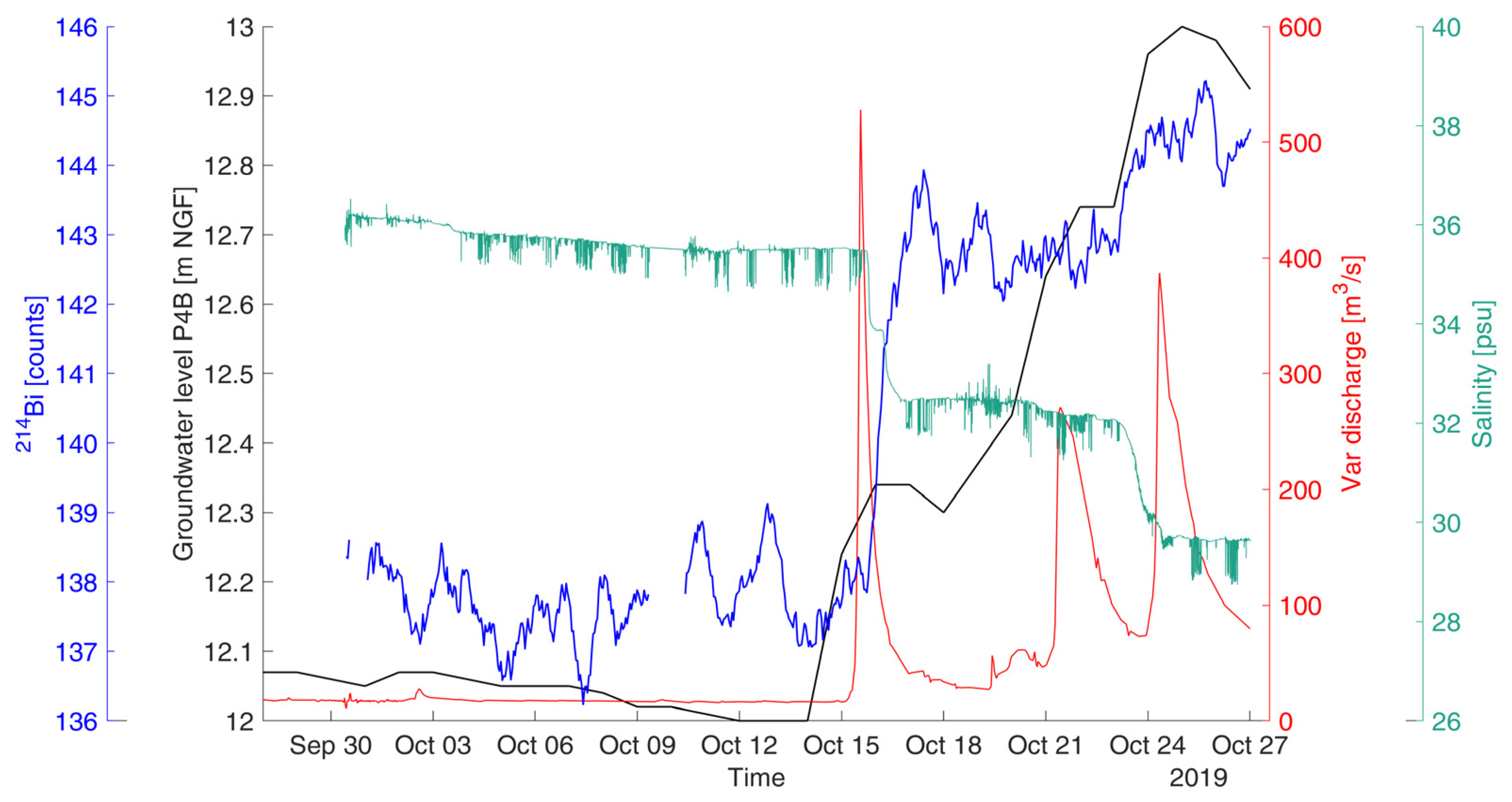
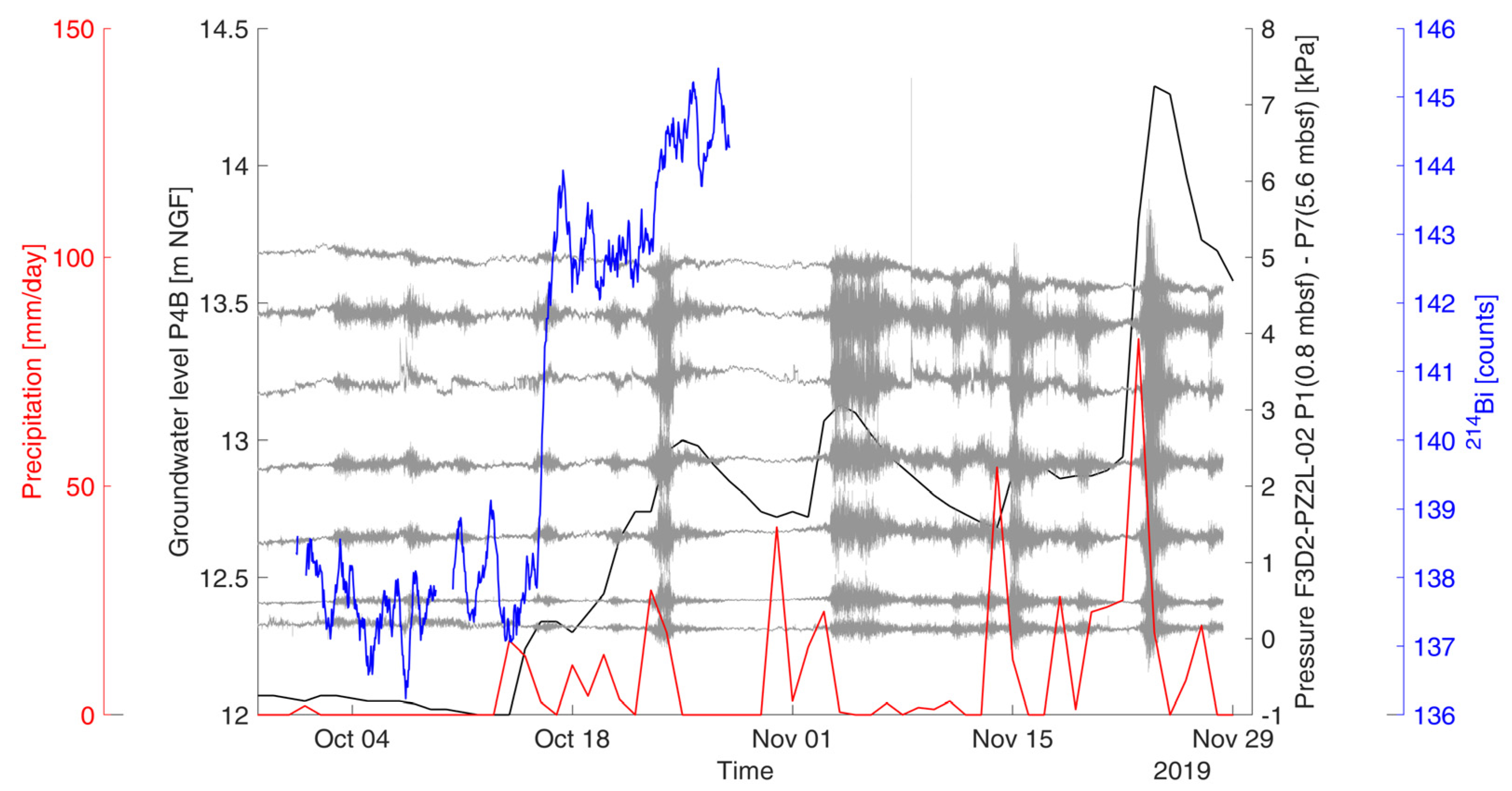
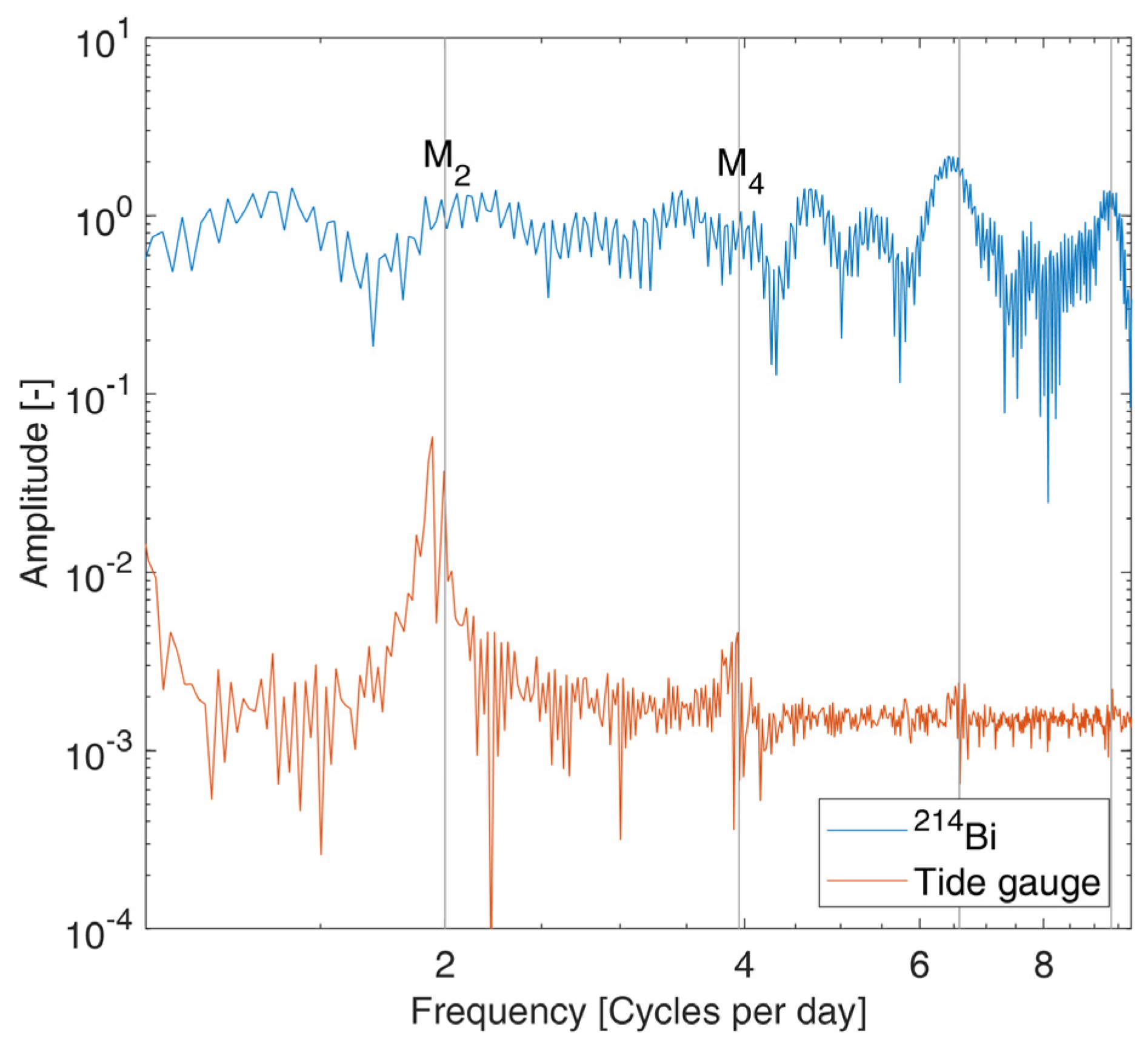
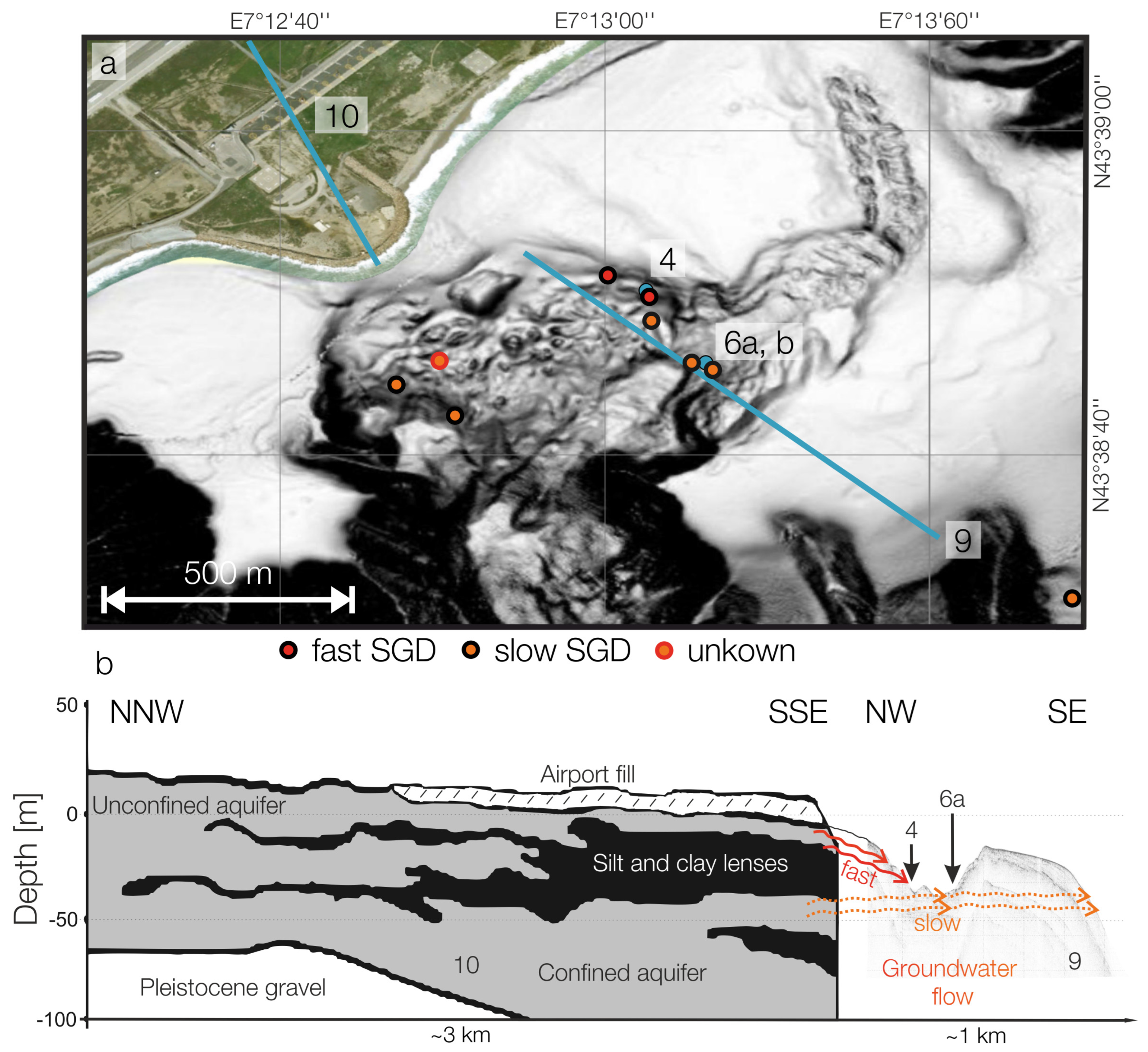
| # | Name | Coordinates | Altitude [m] | Recording Period |
|---|---|---|---|---|
| Underwater mass spectrometer KATERINA | ||||
| 1 | KAT-Seamonice | N 43.6461, E 7.2185 | −40 | 6 h in November 2018 |
| 2 | KAT-Scar | N 43.64725, E 7.21748 | −29 | 14 h in November 2018 |
| 3 | KAT-Plateau | N 43.643798, E 7.21862 | −19 | 6 h in November 2018 |
| 4 | F3D2-KT-02 | N 43.64725, E 7.21748 | −29 | 26 August 2019–07 November 2019 |
| CTD—device | ||||
| 5 | CTD-2019 | N 43.64725, E 7.21748 | −29 | 26 August 2019–07 November 2019 |
| Offshore piezometer | ||||
| 6a | Seamonice (PZ1-N2) | N 43.6461, E 7.2185 | −40 | 29 November 2006–03 November 2007 |
| 6b | F3D2-PZ2L-02 | N 43.64592, E 7.21832 | −40 | 23 August 2019–28 November 2019 |
| 6c | ST5-PZ2L-01 | N 43.64423, E 7.2192 | −19 | 30 April 2015–today |
| Groundwater piezometer | ||||
| 7 | P4B | N 43.69145, E 7.19398 | 17 | 19 July 2005–today |
| Var discharge | ||||
| 8 | Y6442015 | N 43.66407, E 7.20003 | 0 | 22 January 2016–today |
| Chirp | ||||
| 9 | HA0102 | N 43.64267, E 7.22291– N 43.64832, E 7.21592 | - | 25 August 2009 |
| Geological profile | ||||
| 10 | Profile A-A | N 43.66899, E 7.20002– N 43.64742, E 7.21146 | - | [23,26] |
Disclaimer/Publisher’s Note: The statements, opinions and data contained in all publications are solely those of the individual author(s) and contributor(s) and not of MDPI and/or the editor(s). MDPI and/or the editor(s) disclaim responsibility for any injury to people or property resulting from any ideas, methods, instructions or products referred to in the content. |
© 2025 by the authors. Licensee MDPI, Basel, Switzerland. This article is an open access article distributed under the terms and conditions of the Creative Commons Attribution (CC BY) license (https://creativecommons.org/licenses/by/4.0/).
Share and Cite
Witt, C.; Kopf, A. Submarine Groundwater Discharge in the Nice Airport Landslide Area. J. Mar. Sci. Eng. 2025, 13, 909. https://doi.org/10.3390/jmse13050909
Witt C, Kopf A. Submarine Groundwater Discharge in the Nice Airport Landslide Area. Journal of Marine Science and Engineering. 2025; 13(5):909. https://doi.org/10.3390/jmse13050909
Chicago/Turabian StyleWitt, Christoph, and Achim Kopf. 2025. "Submarine Groundwater Discharge in the Nice Airport Landslide Area" Journal of Marine Science and Engineering 13, no. 5: 909. https://doi.org/10.3390/jmse13050909
APA StyleWitt, C., & Kopf, A. (2025). Submarine Groundwater Discharge in the Nice Airport Landslide Area. Journal of Marine Science and Engineering, 13(5), 909. https://doi.org/10.3390/jmse13050909







